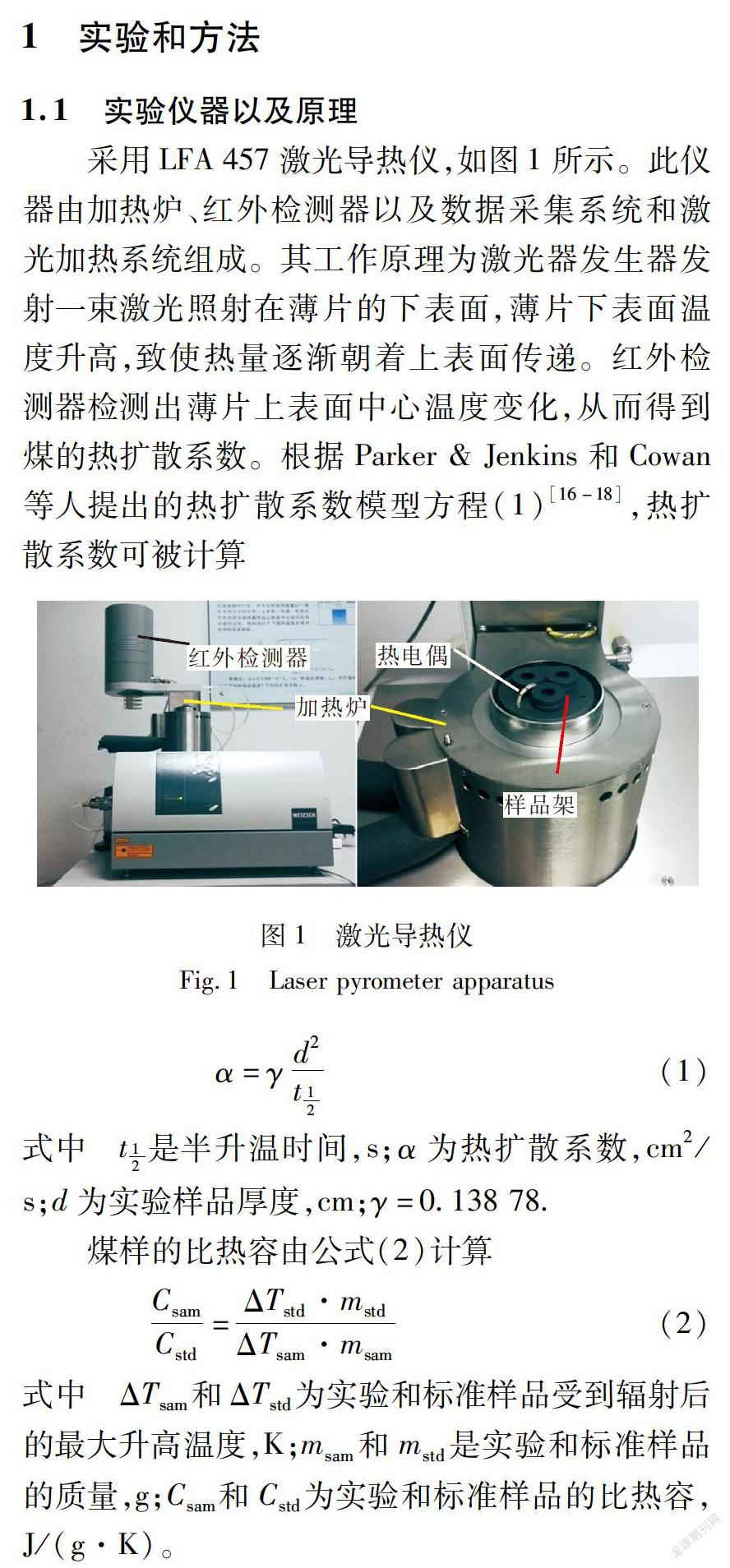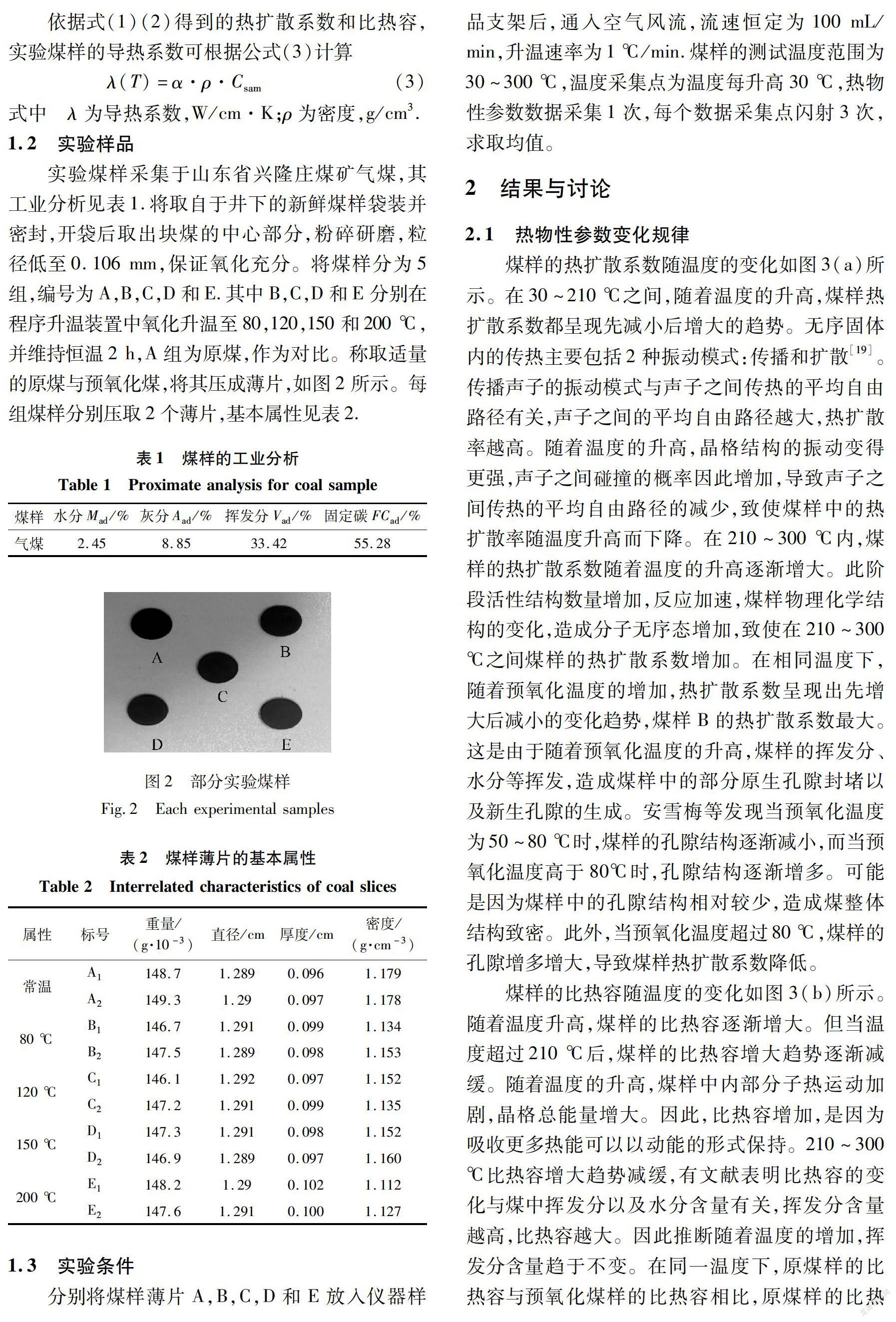不同程度预氧化煤传热特性
张辛亥 周山林 拓龙龙




摘 要:选用气煤,预先在程序升温装置中分别氧化升温至80,120,150和200 ℃,原煤作为对照组,探究煤复燃的热量传递规律。采用激光导热仪FLA457分别测量空气气氛中原煤与预氧化煤在30~300 ℃内的热物性参数,对热物性参数进行拟合分析,并探究其对温度的敏感性。结果表明:在30~300 ℃内,随着温度的升高,煤样热扩散系数先减小后增大,比热容逐渐增大并趋于平稳,导热系数逐渐增大。煤样的热扩散系数变化率以及导热系数变化率呈现出先减小后增大的趋势,比热容变化率逐渐减小。在相同温度下,随着预氧化温度的增加,热扩散系数先增大后减小,导热系数逐渐减小,并且原煤的比热容和导热系数均大于预氧化煤的比热容和导热系数。此外,比热容对温度的敏感性最大。实验结果对于煤火灾害防治具有一定的指导意义。
关键词:预氧化煤;热量传递;热物性参数;敏感性
中图分类号:TD 752.2 文献标志码:A
文章编号:1672-9315(2019)05-0761-06
Abstract:The gas coal was adopted to oxidize at 80,120,150 and 200 ℃ in a temperatureprogrammed oxidation apparatus,with raw coal acting as the control group,to explore the heat transfer law of coal aftercombustion.Laser pyrometer apparatus FLA457 was employed to examine the thermophysical parameters of raw coal and preoxidation coal under air atmosphere within the range of 30~300 ℃.The thermophysical parameters were fitted and the sensitivity of thermophysical parameters on temperature were analyzed.The results indicated that when the temperature increased within the range of 30~300 ℃,thermal diffusivity firstly decreased and then increased,specific heat capacity gradually increased and then tended to be steady,and thermal conductivity gradually increased.With the elevating temperature,the change rate of thermal diffusivity and thermal conductivity showed an increasing trend following a decrease,and the change rate of specific heat capacity gradually decreased.At fixed temperature,with the increase of peroxidation temperature,thermal diffusivity firstly increased and then decreased,thermal conductivity declined,and specific heat capacity of raw coal was bigger than that of preoxidation coals.Furthermore,the sensitivity of specific heat capacity on temperature was the biggest.Those results provide a certain theoretical basis and guiding significance for the prevention of coal fire disaster.
Key words:preoxidation coal;heat transfer;thermophysical parameter;sensitivity
0 引 言
在全球范圍内,世界上所有产煤国都存在不同程度地地下煤层燃烧现象,严重制约着矿井生产[1]。此外,煤火逐渐蔓延,燃烧区域不断扩大,不仅易造成地表塌陷,还会产生大量的有毒有害气体,如SO2,NOX等,从而严重污染环境[2-3]。在煤火蔓延过程中热能主要通过热传导、热对流以及热辐射来实现热能的传递,其中热传导为主要传热方式,表征其热传导特性的参数主要有热扩散系数、比热容和导热系数[4-5]。国内外学者通过实验研究以及数值模拟对热物性参数的演变规律方面进行了一系列的研究。Wen等发现煤的热扩散系数随温度升高而逐渐减小,而比热容以及导热系数呈现出增大的趋势[6];Deng等研究煤在不同气氛中热物性参数的变化趋势,并建立了经验模型,此外,通过敏感性分析,得出在此阶段煤的比热容对温度更敏感[7-8];Zhumagulov等研究发现温度越高煤的导热系数越大,并研究比热容与导热系数的关系[9];肖旸等研究氧化后的煤样在氮气气氛中对温度的敏感性,发现预氧化温度越高,煤样对温度的敏感性越低[10];文虎等研究了不同变质程度的煤的热物性参数,发现热扩散系数和导热系数随着挥发分含量的升高而逐渐降低,然而比热容呈现出逐渐升高的趋势[11];Melchior等研究发现煤的比热容随着温度的升高而增大[12];Herrin等研究不同的煤在室温下的导热系数,研究其工业分析与导热系数之间的关系[13];肖旸等通过测试原煤与预氧化煤样的力学特性和热传导热性,研究其力学参数和导热系数之间的关联性[14];褚廷湘等建立了含水松散煤体的物理模型,通过数值模拟研究水分相变对松散煤体导热性的影响[15]。实验主要研究预氧化处理后的煤在空气气氛中的热物性参数随温度的变化规律。首先,实验煤样预先在程序升温装置中分别氧化升温至80、120、150和200℃,制备预氧化煤样。然后,使用激光导热仪FLA457测量原煤以及预氧化煤的热物性参数,获取煤样的热物性参数,从而研究原煤以及预氧化煤的热物性参数随温度的变化规律,对比分析原煤与氧化后的煤的热传递规律。实验结果对于了解煤层复燃和火灾蔓延过程中的传热具有指导意义。
1 实验和方法
1.1 实验仪器以及原理
1.3 实验条件
分别将煤样薄片A,B,C,D和E放入仪器样品支架后,通入空气风流,流速恒定为100 mL/min,升温速率为1 ℃/min.煤样的测试温度范围为30~300 ℃,温度采集点为温度每升高30 ℃,热物性参数数据采集1次,每个数据采集点闪射3次,求取均值。
2 结果与讨论
2.1 热物性参数变化规律
煤样的热扩散系数随温度的变化如图3(a)所示。在30~210 ℃之间,随着温度的升高,煤样热扩散系数都呈现先减小后增大的趋势。无序固体内的传热主要包括2种振动模式:传播和扩散[19]。传播声子的振动模式与声子之间传热的平均自由路径有关,声子之间的平均自由路径越大,热扩散率越高。随着温度的升高,晶格结构的振动变得更强,声子之间碰撞的概率因此增加,导致声子之间传热的平均自由路径的减少,致使煤样中的热扩散率随温度升高而下降。在210~300 ℃内,煤样的热扩散系数随着温度的升高逐渐增大。此阶段活性结构数量增加,反应加速,煤样物理化学结构的变化,造成分子无序态增加,致使在210~300 ℃之间煤样的热扩散系数增加。在相同温度下,随着预氧化温度的增加,热扩散系数呈现出先增大后减小的变化趋势,煤样B的热扩散系数最大。这是由于随着预氧化温度的升高,煤样的挥发分、水分等挥发,造成煤样中的部分原生孔隙封堵以及新生孔隙的生成。安雪梅等发现当预氧化温度为50~80 ℃时,煤样的孔隙结构逐渐减小,而当预氧化温度高于80℃时,孔隙结构逐渐增多。可能是因为煤样中的孔隙结构相对较少,造成煤整体结构致密。此外,当预氧化温度超过80 ℃,煤样的孔隙增多增大,导致煤样热扩散系数降低。
煤样的比热容随温度的变化如图3(b)所示。随着温度升高,煤样的比热容逐渐增大。但当温度超过210 ℃后,煤样的比热容增大趋势逐渐减缓。随着温度的升高,煤样中内部分子热运动加剧,晶格总能量增大。因此,比热容增加,是因为吸收更多热能可以以动能的形式保持。210~300 ℃比热容增大趋势减缓,有文献表明比热容的变化与煤中挥发分以及水分含量有关,挥发分含量越高,比热容越大。因此推断随着温度的增加,挥发分含量趋于不变。在同一温度下,原煤样的比热容与预氧化煤样的比热容相比,原煤样的比热容最大,表明氧化后的煤中挥发分、水分等发生相变,逐渐减少,引起预氧化煤样的比热容降低。
煤样的导热系数随温度的变化如图3(c)所示。随着温度的升高,煤样的导热系数逐渐增大,当温度超过210 ℃,煤样的导热系数快速增大。在30~210 ℃之间,煤样的导热系数缓慢增加,是因为比热容的增长率高于热扩散系数的下降率;在210~300 ℃,煤樣的热扩散系数增加,比热容趋于稳定,导热系数迅速增加。在相同温度下,随着预氧化温度的增大,煤样的导热系数逐渐减小。
2.2 热物性参数拟合
为了揭示热物性参数与温度之间的关系,根据式(4)(5)(6)分别对热扩散系数、比热容以及导热系数进行拟合,如图4所示,拟合参数见表3,表4和表5.拟合度越高,表明式(4)、(5)和(6)适用于揭示热物理参数与温度之间的关系。
从图5(a)可看出,随着温度的升高,在30~210 ℃之间,煤样的热扩散系数的变化率逐渐减小,当温度超过210 ℃后,热扩散系数变化率增大。在相同温度下,煤样的热扩散系数变化率随着预氧化温度的升高而逐渐减少。这是由于随着预氧化温度的升高,煤中的声子数逐渐增多,并逐渐趋于饱和状态,导致其对温度的敏感性降低。从图5(b)可看出,煤样的比热容变化率随着温度的升高逐渐降低,表明煤样的比热容随着温度升高逐渐趋于平稳。在相同温度下,煤样D的比热容变化率与其它煤样相比,煤样D的比热容变化率最大。这可能是由于当预氧化温度在150 ℃以下时,煤样吸收氧气以产生不稳定的碳氧化物。不稳定的碳氧化物越多,比热容越敏感。从图5(c)可看出,在30~150 ℃之间,随着温度的升高,导热系数的变化率逐渐减小,当温度超过150 ℃后,导热系数的变化率逐渐增大,表明导热系数呈现出先缓慢增加后快速增大。在相同温度下,随着预氧化温度的增大,导热系数的变化率逐渐减小。此外,比热容的变化率与热扩散系数以及导热系数的变化率相比,比热容的变化率最大,表明比热容对温度更敏感。
3 结 论
1)在30~210 ℃之间,随着温度的升高,煤样热扩散系数逐渐减小,比热容逐渐增大,导热系数逐渐增大。当温度超过210 ℃,煤样的热扩散系数逐渐增大,比热容增大趋势趋于平稳,导热系数快速增大。
2)在相同温度下,随着预氧化温度的增加,热扩散系数呈现出先增大后减小的变化趋势,并且原煤的比热容和导热系数均大于预氧化煤的比热容和导热系数,导热系数逐渐减小,并且比热容对温度的敏感性最大。
3)在30~210 ℃之间,随着温度的升高,煤样的热扩散系数变化率减小,当温度超过210 ℃,其变化率增大,并且在30~150 ℃之间,随着温度的升高,导热系数的变化率减小,当温度超过150 ℃后,其变化率增大,在30~300 ℃之间,随着温度的升高,比热容变化率逐渐减小。
参考文献(References):
[1] Song Z,Kuenzer C.Coal fires in China over the last decade:a comprehensive review[J].International Journal of Coal Geology,2014,133(1):72-99.
[2]Song Z,Zhu H,Tan B,et al.Numerical study on effects of air leakages from abandoned galleries on hillside coal fires[J].Fire Safety Journal,2014,69:99-110.
[3]Pandey J,Mohalik NK,Mishra RK,et al.Investigation of the role of fire retardants in preventing spontaneous heating of coal and controlling coal mine fires[J].Fire Technology,2015,51(2):227-245.
[4]Guan W,Chen Q,Xu M,et al.Analysis on influential factors of loose coal thermal conductivity test accuracy[J].International Journal of Mining and Mineral Engineering,2014,5(2):106-116.
[5]Liu X,Wang G,Pan G,et al.Numerical analysis of heat transfer and volatile evolution of coal particle[J].Fuel,2013,106:667-673.
[6]Wen H,Lu J,Xiao Y,et al.Temperature dependence of thermal conductivity,diffusion and specific heat capacity for coal and rocks from coalfield[J].Thermochimica Acta,2015,619(10):41-47.
[7]Deng J,Li Q W,Xiao Y,et al.Experimental study on the thermal properties of coal during pyrolysis,oxidation,and reoxidation[J].Applied Thermal Engineering,2017,110(5):1137-1152.
[8]Deng J,Li Q W,Xiao Y,et al.Predictive models for thermal diffusivity and specific heat capacity of coals in Huainan mining area,China[J].Thermochimica Acta,2017,656(10):101-111.
[9]Zhumagulov M G.Experimental study of thermophysical properties of Shubarkol coal[J].Chemistry and Technology of Fuels and Oils,2013,49(2):100-107.
[10]肖 旸,尹 嵐,马 砺,等.不同预氧化温度下煤样热物性参数的实验研究[J].西安科技大学学报,2018,38(3):383-388.
XIAO Yang,YIN Lan,MA Li,et al.Experimental study on coal thermophysical parameters under the different peroxidation temperature[J].Journal of Xi’an University of Science and Technology,2018,38(3):383-388.
[11]鲁军辉.煤田火区煤岩体热物性参数及热破坏特性研究[D].西安,西安科技大学,2016.
LU Junhui.Research on thermal physical parameters and destruction characteristics of coal and rock of coalfield fire area[D].Xi’an:Xi’an University of Science and Technology,2016.
[12]Melchior E,Luther H.Measurement of true specific heats of bituminous coals of different rank,and of a hightemperature coke,in the temperature range 30 350C[J].Fuel,1982,61(11):1071-1079.
[13]Herrin J M,Deming D.Thermal conductivity of US coals[J].Journal of Geophysical Research:Solid Earth(1978 2012),1996,101(B11):25381-25386.
[14]肖 旸,刘志超,周一峰,等.预氧化煤体的力学参数和导热特性关系研究[J].煤炭科学技术,2018,46(4):135-140.
XIAO Yang,LIU Zhichao,ZHOU Yifeng,et al.Study on relationship between mechanical parameters and thermal conductivity of preoxidized coal[J].Coal Science and Technology,2018,46(4):135-140.
[15]褚廷湘,李 品,余明高.水分相变下松散煤体导热系数的数值模拟研究[J].煤炭学报,2017,42(7):1782-1789.
ZHU Tingxiang,LI Pin,YU Minggao.Simulation study of water phase transition effects on thermal conductivity of loose coal[J].Journal of China Coal Society,2017,42(7):1782-1789.
[16]Parker W J,Jenkins R J.Thermal conductivity measurements on bismuth telluride in the presence of a 2MeV electron beam[J].Advanced Energy Conversion,1962(2):87-103.
[17]Cowan R D.Proposed method of measuring thermal diffusivity at high temperatures[J].Journal of Applied Physics,1961,32(7):1363-1370.
[18]Cowan R D.Pulse method of measuring thermal diffusivity at high temperatures[J].Journal of Applied Physics,1963,34(4):926-927.
[19]Zhu T,Ertekin E.Phonons,localization,and thermal conductivity of diamond nanothreads and amorphous graphene[J].Nano letters,2016,16(8):4763-4772.

